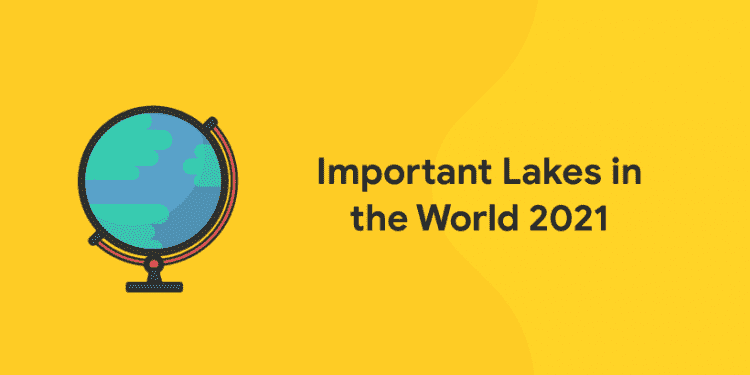The world is home to over 100 million lakes. There are different types of lakes like Tectonic, Volcanic, Glacial, Fluvial and Shoreline lakes etc. Lakes are important for different reasons, like regulating the flow of river water, storage of water during the dry seasons, to maintaining the Eco-system, and also the generation of hydroelectric power. Proper functioning lakes can ease the impact of floods and droughts by storing large amounts of water and releasing it during scarcity. Lakes are prime locations for recreation, tourism, and cottage or residential living. Important Lakes in the World 2021 will provide you with information on important lakes on earth, largest lakes in the world.
Download Entri App and attempt free GK quiz
Important Lakes in the World 2021
As humans we cannot undermine the value of lakes in our lives. Lakes are a boon not only to humans but also animals, birds. During heavy rainfall, it prevents flooding and during the dry season, it helps to maintain an even flow of water. Lakes can be used for developing hydroelectric power too. Let us take a look at largest and important lakes on earth below.
List of Largest Lakes in the World
Below mentioned are the largest lakes in the world by surface area.
|
Name of the Lake |
Countries With Shoreline |
Surface Area |
|
Caspian Sea |
Kazakhstan Russia Turkmenistan Azerbaijan Iran |
371,000 km2 (143,000 sq. mi) |
|
Superior |
Canada United States |
82,100 km2 (31,700 sq. mi) |
|
Victoria |
Uganda Kenya Tanzania |
68,870 km2 (26,590 sq. mi) |
|
Huron |
Canada United States |
59,600 km2 (23,000 sq. mi) |
| Michigan | United States |
58,000 km2 (22,000 sq. mi) |
|
Tanganyika |
Burundi Tanzania Zambia Democratic Republic of the Congo |
32,600 km2 (12,600 sq. mi) |
|
Baikal |
Russia | 31,500 km2 (12,200 sq. mi) |
| Great Bear Lake | Canada |
31,000 km2 (12,000 sq. mi) |
|
Malawi |
Malawi Mozambique Tanzania |
29,500 km2 (11,400 sq. mi) |
| Great Slave Lake | Canada |
27,000 km2 (10,000 sq. mi) |
|
Erie |
Canada United States |
25,700 km2 (9,900 sq. mi) |
| Winnipeg | Canada |
24,514 km2 (9,465 sq. mi) |
|
Ontario |
Canada United States |
18,960 km2 (7,320 sq. mi) |
| Ladoga | Russia |
18,130 km2 (7,000 sq. mi) |
|
Balkhash |
Kazakhstan | 16,400 km2 (6,300 sq. mi) |
| Bangweulu | Zambia |
15,100 km2 (5,800 sq. mi) |
|
Vostok |
Antarctica | 12,500 km2 (4,800 sq. mi) |
| Onega | Russia |
9,700 km2 (3,700 sq. mi) |
|
Titicaca |
Bolivia Peru |
8,372 km2 (3,232 sq. mi) |
|
Nicaragua |
Nicaragua | 8,264 km2 (3,191 sq. mi) |
| Athabasca | Canada |
7,850 km2 (3,030 sq. mi) |
|
Taymyr |
Russia |
6,990 km2 (2,700 sq. mi) |
|
Turkana |
Ethiopia |
6,405 km2 (2,473 sq. mi) |
| Reindeer Lake | Canada |
6,330 km2 (2,440 so mi) |
|
Issyk-Kul |
Kyrgyzstan |
6,200 km2 (2,400 sq. mi) |
|
Urmia |
Iran |
6,001 km2 (2,317 sq. mi) |
|
Vänern |
Sweden |
5,545 km2 (2,141 sq. mi) |
|
Winnipegosis |
Canada |
5,403 km2 (2,086 sq. mi) |
|
Albert |
Uganda |
5,299 km2 (2,046 sq. mi) |
|
Mweru |
Zambia |
5,120 km2 (1,980 sq mi) |
|
Nettilling |
Canada |
5,066 km2 (1,956 sq mi) |
|
Nipigon |
Canada |
4,843 km2 (1,870 sq mi) |
|
Manitoba |
Canada |
4,706 km2 (1,817 sq mi) |
|
Qinghai Lake |
China |
4,489 km2 (1,733 sq mi) |
|
Saimaa |
Finland |
4,400 km2 (1,700 sq mi) |
|
Lake of the Woods |
Canada |
4,350 km2 (1,680 sq mi) |
|
Khanka |
China |
4,190 km2 (1,620 sq mi) |
|
Sarygamysh |
Uzbekistan |
3,955 km2 (1,527 sq mi) |
|
Dubawnt |
Canada |
3,833 km2 (1,480 sq mi) |
|
Van |
Turkey |
3,755 km2 (1,450 sq mi) |
|
Peipus |
Estonia |
3,555 km2 (1,373 sq mi) |
|
Uvs |
Mongolia |
3,350 km2 (1,290 sq mi) |
|
Poyang |
China |
3,210 km2 (1,240 sq mi) |
|
Tana |
Ethiopia |
3,200 km2 (1,200 sq mi) |
|
Amadjuak |
Canada |
3,115 km2 (1,203 sq mi) |
|
Melville |
Canada |
3,069 km2 (1,185 sq mi) |
Largest Lake in the World by Surface Area
- Caspian Sea – The name Caspian sea might confuse you into thinking it is a sea and not a lake. Do not let the name fool you. Even though it is called a sea due to its size and saline water, it has most features of a lake. The salty Caspian Sea has the greatest surface area of 143,200 square miles (370,886 square kilometers), which makes it the largest lake in the world by surface. The sea stretches nearly 1,200 kilometers from north to south, with an average width of 320 km. The Caspian Sea is home to a number of species of sturgeon; one of the most famous fish in Russia; and a fish whose eggs, Caviar are relished as a delicacy all around the world.
Largest Lake in the World by Volume
- Lake Baikal – In terms of volume, Lake Baikal is the world’s largest freshwater lake. It contains about 5,521 cubic miles of water (23,013 cubic kilometers), or approximately 20% of Earth’s fresh surface water. This volume of water is approximately equal to the volume of water of the five North American Great Lakes combined. While Lake Baikal is extremely deep, its surface area is only about 12,248 square miles (31,722 square kilometers). Hence, it stands at seventh place worldwide in terms of surface area.
We hope this article on Important Lakes in the World 2021 helps you in your preparation for competitive exams. Entri wishes you best of luck for your upcoming exams. Click here to view Important Indian Cities and Their Founders 2021












